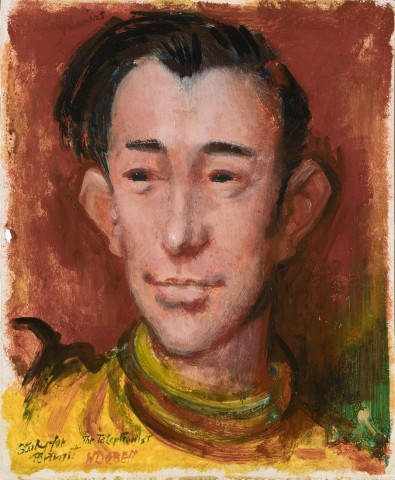By 1946, William Dobell was hailed as ‘Australia’s most distinguished painter’.1 He was only 47, had won the 1943 Archibald Prize with Portrait of an Artist – Joshua Smith, and exhibitions of his work drew crowds ‘almost equal to a fair day at Randwick Racecourse’.2 In The Strapper, 1941 (Newcastle Art Gallery, New South Wales), Brian Penton, 1943 (once in Sir Frank Packer’s collection), and The Billy Boy, 1943 (Australian War Memorial, Canberra), he had already painted some of the finest portraits known to Australian art. More were to follow in such masterpieces as Margaret Olley, 1948 and Dame Mary Gilmore, 1957, both in the collection of the Art Gallery of New South Wales, Sydney. The portrait of Olley won the 1948 Archibald and his Storm Approaching Wangi took the Wynne Prize that year, the first time such a double had been achieved. Returning to 1946, the year of our portrait, Sydney Ure Smith published a monograph on Dobell, richly illustrated and representing ‘a comprehensive record of his work’.3
Dobell was drawn by character expressed through the appearance of the individual, using both image and technique to recreate it as a work of art in paint. At times his then highly imaginative approach resulted not so much in portraits, but absorbing inventions based on character types. In Mrs South Kensington, 1937 (Art Gallery of New South Wales) the paint is as dry and scratchy as the person, and in The Red Lady, 1937 (National Gallery of Australia, Canberra) the amplitude of her body and personality expands the composition. For The Strapper, 1941, Dobell groomed and pampered the paint as the strapper might care for the thoroughbred. Study for Portrait – The Telephonist, 1946 shares with The Strapper and Joshua Smith striking oval heads and prominent ears. But being a head study, there are no hands nor the same degree of technical finesse through which to speak of character and professional interest. The painting’s intriguing genesis explains why. The ever-generous Dobell had agreed to give a painting to an exhibition and raffle at David Jones Art Gallery, Sydney, in late February 1946. Held ‘under the auspices of the French Comforts Fund’ it was to help destitute French artists.4 Some 110 oils, watercolours, prints and drawings were donated, each holder of a five-guinea ticket being entitled to a picture at the draw taken on the last day of February.5 Three thousand people were reported to have visited the exhibition in the one week. Brian Adams, in his 1983 book on Dobell, tells us that Dobell experienced his usual difficulties ‘meeting the deadline’:
At the last minute he submitted a painting titled Study of a Telephonist which he admitted had taken only six and a half hours to complete – ‘the fastest I’ve ever worked’.6
The subject was a young telephonist who had recently installed a telephone for Dobell. While the quick application of paint may have been a necessity, it also enabled Dobell to capture the open-faced affability of the sitter. Dobell must have liked the painting for, years later, it was included in the major retrospective exhibition arranged by the Art Gallery of New South Wales in 1964 in honour of the artist.
1. Penton, B., ‘Introduction’, Ure Smith, S. (ed.), The Art of William Dobell, Ure Smith Pty Limited, Sydney, 1946, p. 11
2. ibid.
3. Ure Smith, S., ‘Preface’, The Art of William Dobell, op. cit., p. 9
4. ‘Aid for French artists’, Sydney Morning Herald, Sydney, February 14, 1946, p. 6
5. Caption to photograph, Sydney Morning Herald, Sydney, 1 March 1946, p. 3
6. Adams, B., Portrait of an Artist: A Biography of William Dobell, Hutchinson of Australia, Victoria, 1983, p. 228. There is an interesting postscript. Adams tells that the Meldrumite painter Hayward Veal invited Dobell ‘to a speed painting contest’. Dobell declined.
DAVID THOMAS
